 I’ve been out of the country for a month, California to be precise, so it’s good to be home and to be greeted with a whole week without a snow storm. I’ve been trying to decide if I want to buy one or two moose hunting lottery tickets for next season. In Sweden, I understand prospective hunters need to score on a running moose target before being issued a permit. In Maine, I believe we just need to be able to locate Frostbite Falls on a map. Anyway…
I’ve been out of the country for a month, California to be precise, so it’s good to be home and to be greeted with a whole week without a snow storm. I’ve been trying to decide if I want to buy one or two moose hunting lottery tickets for next season. In Sweden, I understand prospective hunters need to score on a running moose target before being issued a permit. In Maine, I believe we just need to be able to locate Frostbite Falls on a map. Anyway…
Good range day today. I got to head out this morning with a new .416 Ruger M77 Hawkeye Alaskan and several boxes of factory ammo, then return home with the gun, a pile of empty brass, feeling…”invigorated”. The .416 Ruger cartridge and rifle are an interesting combination. It is no mean feat, as opposed to no mean feet, to get so much heavy hitting performance into such a compact firearm and have a shooter survive to tell the story. The Hawkeye tracks, points and carries like my stubby Marlin 1895 Guide Gun, but it hits faster and hits harder than a .416 Rigby, even when the Rigby’s barrel is 4″ longer. In summary, the gun looks a bit like this:
| Weights & Measures | Spec or Observed |
| Weight | 7 lbs 15 oz |
| Overall Length | 40.75″ |
| Barrel Length | 20″ |
| Grooves | 6 |
| Twist | 1:14″ |
| Hardware | Stainless – Matte |
| Trigger | LC6 5 lbs 2 oz pull |
| Safety | Three position |
| Sights | Windage Adjustable |
| Sight elevation | 50 yard preset |
| Sight radius | 13.750″ |
| Stock | Hogue Overmolded |
| Pull | 13.75″ |
| Drop at comb | 0.625″ |
| Drop at heal | 0.750″ |
| Magazine | Hinged Floorplate |
| Magazine Capacity | Three |
Ruger and Hornady seem to be placing an emphasis on high performance, lightweight, short barreled firearms. The result this time around is a big and dangerous game rifle that is light enough to carry in the field without employing the services of a gun bearer. Yes, that’s right, a hunter can barbeque and drink beer with friends and loved ones during the off season, not spend a day at the gym and still carry his own rifle during hunting season. Somehow, I don’t think the latter was what Ruger had in mind, but the gun’s light weight does offer some excellent possibilities.
I know what you’re thinking, “What about the dynamics of diminishing weight and exponentially increasing recoil?” Ruger did a good job when considering recoil management during the design of the firearm. The Hawkeye has the right stock geometry and the right recoil absorbing materials in stock and recoil pad components to assure reduced felt recoil.
Does the sub eight pound Hawkeye kick behind the big .416 Ruger cartridge? You betcha, but it is not severe, not bone jarring and less than I have experienced with my own heavy .375 H&H express guns. Besides, complaining about recoil from a rifle that is intended to hunt big and dangerous game is just a little unrealistic. Anyone shooting a gun with this level of power should expect to get shoved around a bit, but it won’t be very often. Beyond proficiency training and shots taken while hunting, guns of this type don’t typically see a lot of recreational target shooting, nor are they typically dragged out for an afternoon of plinking.
My extended range experience? The .416 Ruger appears to have left somewhat of an impression on my shoulder, but not to any significant degree. The front of my trigger finger was a little sore from getting rapped by the inside of the trigger guard, however, just the tasty fried egg and bagel breakfast sandwich that followed the range session was enough to erase that trauma.
Details, details, details…
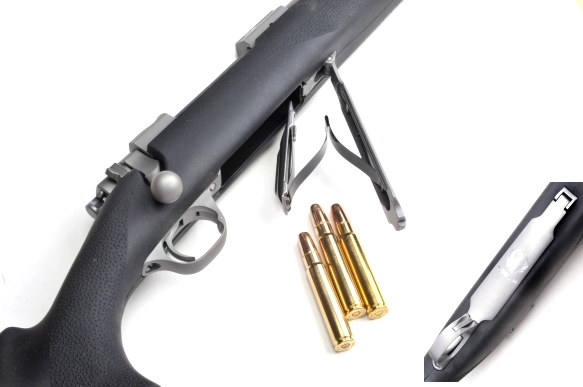
The Hawkeye Alaskan, when chambered for the .416 Ruger, has a three shot magazine capacity and another in the chamber makes for a total capacity of four. The floorplate release is recessed into the front face of the trigger guard. This location was selected to prevent fingers inside the guard from accidentally tripping the release and dumping the magazine contents on the ground at an inopportune time. The nifty Ruger logo is emblazoned very tastefully on the face of the floorplate. The hinged floorplate and trigger guard are two separate stainless pieces, the guard anchored with two fasteners, the floorplate with one beefy fastener. The beefy fastener on the rifle I was shooting was torqued to just about eight million foot pounds. Yes, that is a modest exaggeration. Ruger tech support tells me this fastener should be hand tightened only.
A little self absorbed perhaps?
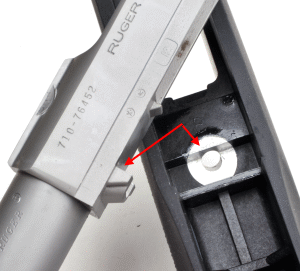
As noted previously, recoil management can be designed into a firearm, and some of that effort can go into material selection and stock design. The fiberglass reinforced polymer Hogue stock’s interior is molded so that it very closely matches up with shape of the Ruger action, helping to secure it in place. The two assemblies are clamped together with three fasteners and pillar bedded at two of the locations.
The front fastener passes through the floorplate frame, through a thick walled aluminum bushing that is embedded in the stock and then into the front recoil lug that is cast integral to the Ruger’s action. The top of the aluminum bushing is stepped to allow it to interlock with the recoil lug and absorb longitudinal forces produced under recoil. The two rear guard screws also secure the stock to the action. The farthest aft passes through a second thick-walled bushing embedded in the stock. This bushing prevents the stock material from collapsing under the clamping pressure of the fastener and it keeps the gun’s barrel parallel to the barrel channel.
Good things don’t have to be complicated…
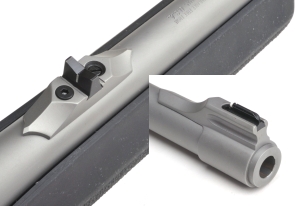
The Ruger has a mission appropriate sight system. The rear is adjustable for windage, set by loosening the forward fastener and moving it with light finger pressure left or right. The banded front sight’s blade is slipped to a dovetail and secured with a small set screw.
The rear sight is a shallow “V” type; fast on target, good visibility, preset at the factory to vertical zero at 50 yards. I’m glad to see Ruger avoided folding leaf express sights as they are essentially useless at over 100 yards and they require a lot of hand crafting just to place a limited number of loads on target.
A gun like this really needs open sights as backup and, in fact, open sites in some settings may be all that is required…unless you’re me. I find the best way for a guy with my eyesight to utilize the metallic sights is to ignore them and bolt on a scope. A set of Ruger’s proprietary 1″ rings are included with the rifle. 30mm types are available as an extra cost accessory for those of us who have gone Euro, or expensive in scope selection. I’d like to see a selection of different front sight inserts in various contrasting colors and perhaps a light pipe version.
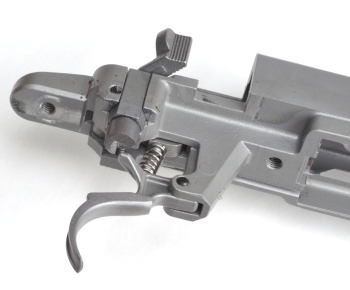
The Hawkeye utilizes Ruger’s LC6 trigger. It is not intended to be shooter adjustable, however, it is a creep free trigger with a clean break. The preset 5 lb pull is a light enough for this type of rifle. I know some folks like to be able to exercise control over every aspect of trigger pull. I’m just not that trigger sensitive under hunting conditions and most people can adapt to different feel with a little practice.
The safety is three position; on, off and on but allowing bolt operation. If you look at the notched cylinder under the safety you will see the safety positively blocks the trigger when it is switched to the “Safe” positioned.
The .416 Ruger. A thumbnail sketch…
 The first thing I noticed about the .416 Ruger is that it is a very large cartridge, pictured, actual size, left. Yes, that was a feeble attempt at humor. Derived from the .375 Ruger case, the production cartridge dimensions and capacities appear on the table below.
The first thing I noticed about the .416 Ruger is that it is a very large cartridge, pictured, actual size, left. Yes, that was a feeble attempt at humor. Derived from the .375 Ruger case, the production cartridge dimensions and capacities appear on the table below.
| Cartridge | .416 Ruger* | .416 Remington | .416 Rigby |
| Max COL | 3.595″ | 3.600″ | 3.750″ |
| Max Case Length | 2.572″ | 2.850″ | 2.900″ |
| Grains Capacity | 100 | 107 | 132 |
| MAP PSI | 62000 | 54000 | 47000 |
| Factory Ammunition 400 grain Bullet Performance | |||
| Barrel Length | 24″ | 24″ | 24″ |
| MV – FPS | 2400 | 2400 | 2370 |
| ME Ft./Lbs | 5115 | 5115 | 4988 |
| Price per 20 | $58 | $125 | $217 |
| Brand | Hornady | Norma | Norma |
| * Production specification, Pending SAAMI homogulation | |||
Dimensional changes from factory ammo to fired brass
| .416 Ruger | Factory | Once fired |
| COL | 3.236″ | NA |
| Case Length | 2.576″ | 2.582″ |
| Grains Capacity | 100 | 101 |
| Neck OD | 0.440″ | 0.444 |
| Shoulder OD | 0.515″ | 0.517″ |
| Case Head OD | 0.5295″ | 0.5300″ |
At this time, there are two Hornady factory loads available; DGX – Dangerous Game Expanding and DGS – Dangerous Game Solid. Both have an exposed lead heel, a very tough 0.070″ copper clad steel jacket and high antimony lead alloy core. The DGX has an exposed lead tip, the DGS does not.
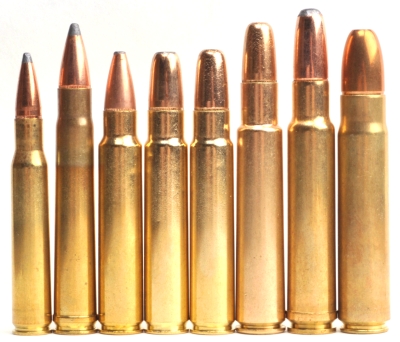
Left to right – .30-06 Springfield, .375 H&H, .375 Ruger, .416 Ruger expanding tip, .416 Ruger solid, .416 Rigby, .416 Weatherby and the ever popular plinker, the .500 Jeffery. More than a gratuitous picture of large cartridges playing out as a Freudian moment, this places the new generation Ruger cartridges right next to the rounds they could ultimately replace. By producing .30-06ish length .375 and .416 cartridge, Ruger opened the door to lighter weight and less costly rifles, higher levels of performance and guns not stretched to their physical limits to accommodate an oversized cartridge.
I handload and shoot all of the cartridges above, but I would be lying if I didn’t say there is little persistent joy in shooting the .500 Jeffery and the Weatherby requires a barrel long enough for pole vaulting (26″+2″ brake”) to produce those big Weatherby factory velocity numbers. Additionally, the rifle carries a price tag three times greater than the Ruger. Does this discourage me from owning and shooting rifles chambered for all of the cartridges above? Of course not, I love guns and these are all very interesting and entertaining, but the Ruger would be my first choice if I had to field carry a gun over difficult ground and in adverse weather conditions. The .416 Ruger is more than powerful enough for the largest game and that is all I would need.
How big is a barn…

I didn’t go for an anchored shooting rest or a high magnification scope. For this part of the project I shot at 50 yards with the Ruger metallic sights. Considering I need to put on reading glasses to find my driving glasses, a 1¼” center to center three shot group left me feeling good about the Ruger’s accuracy potential.
The rifle is easy to shoot. Recoil and muzzle blast didn’t break my concentration, recovery after a shot was fast and it was easy to keep on target. I am looking forward to handload development and getting a scope mounted so results will be more about the rifle and less about my shooting skills and associated limitations.
The chronograph data was also good news. Both the solid and expanding tip ammunition are rated at 2400 fps, with data collected from a 24″ test barrel. The Alaskan 20″ barrel, 4″ shorter, still produced an average velocity of 2369 fps with solids and 2349 with expanding tip bullets; only 31 and 51 fps less, respectively, with a much shorter barreled gun. That is impressive.
It is easy for a cartridge of this type to upstage the rifle, but it shouldn’t. The M77 Hawkeye Alaskan is a slick rifle, optimized for hunting. The action cycles cleanly, feed and ejection are flawless and the fit and finish is of excellent quality. The matte stainless parts have a high resistance to scuffing and the Overmolded stock feels comfortable and slip proof even in very cold weather. I believe the story of the .416 Ruger is just beginning. Hornady brass is available through retail outlets, dies will follow shortly. All are lots and lots of possibilities as there is a good range of bullets available for this bore, in weights from 300 – 450 grains.
MSRP for this model is $1.079, however, if you shop around you should be able to locate one near the $900 mark as long as they are in supply. More to follow…
The .416 Ruger M77 Hawkeye Alaskan Part I
The .416 Ruger M77 Hawkeye Alaskan Part II

Email Notification